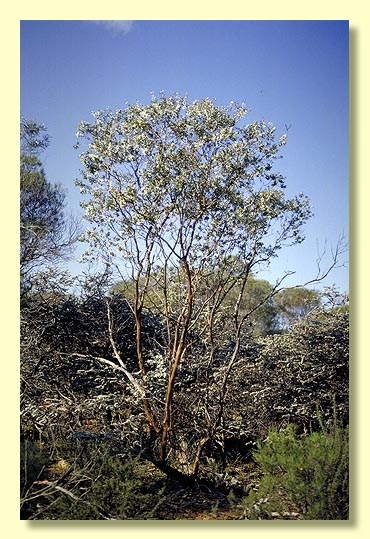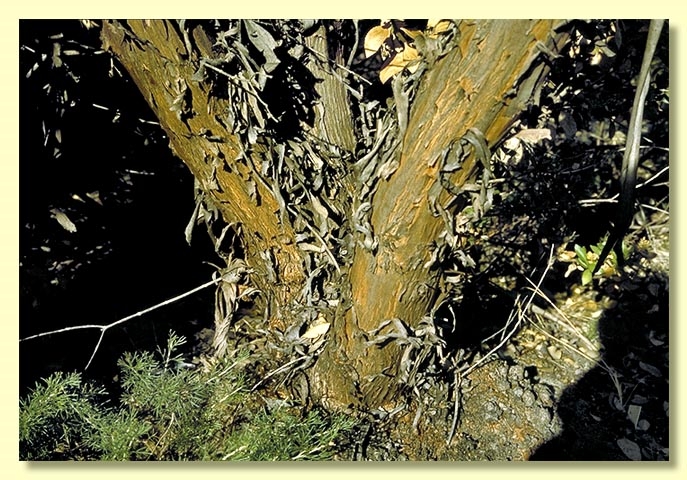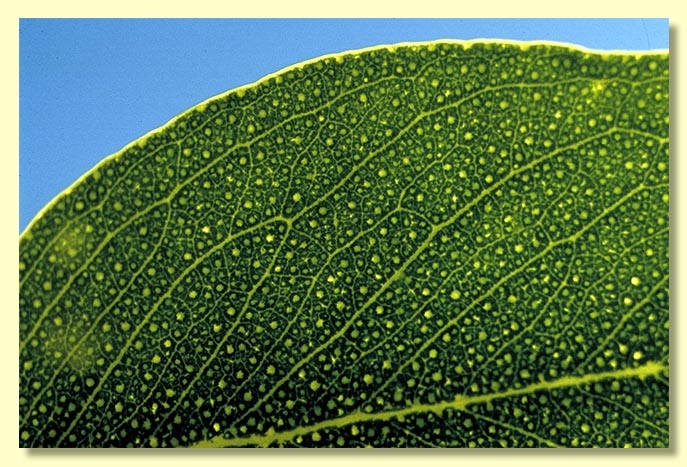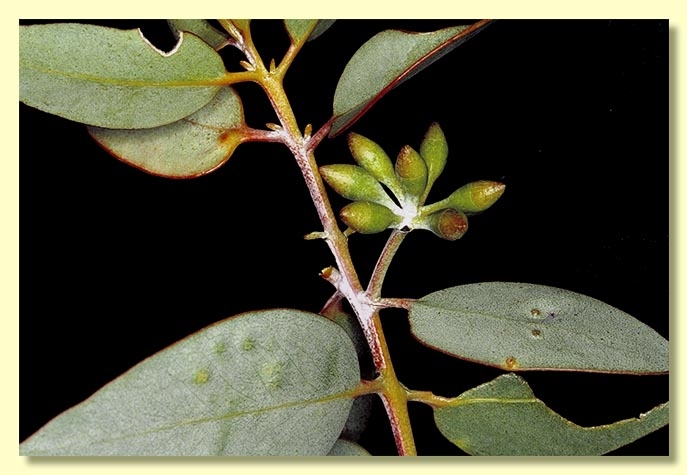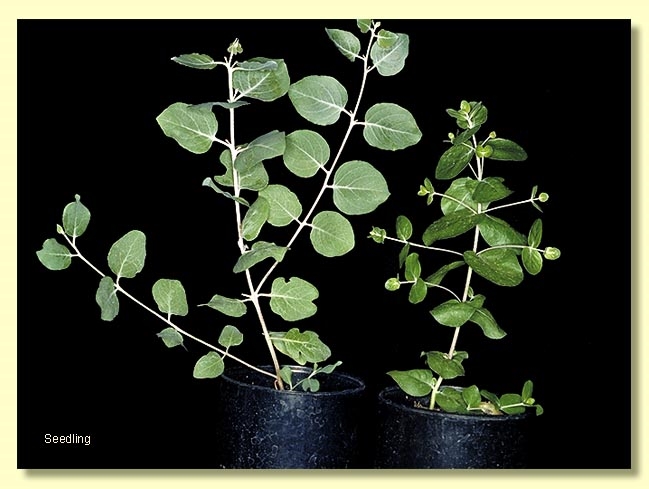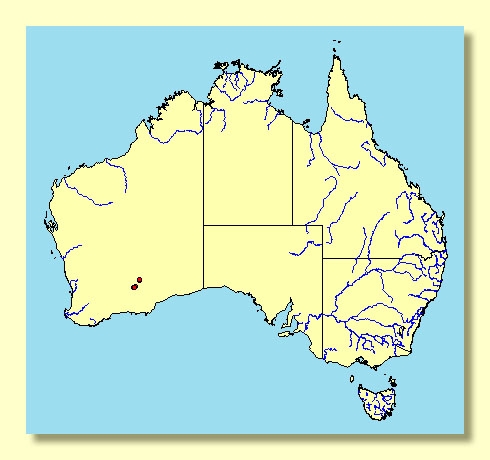Eucalyptus | Symphyomyrtus | Bisectae | Glandulosae
Euclid - Online edition
Eucalyptus brachyphylla
Classification
Nomenclature
Eucalyptus brachyphylla C.A.Gardner, J. & Proc. Roy. Soc. W. Australia 27: 186 (1942).
T: near Lake Cowan, W.A., July 1940, G.E.Brockway s.n.; holo: PERTH.
T: near Lake Cowan, W.A., July 1940, G.E.Brockway s.n.; holo: PERTH.
Description
Tree or mallee to 4 m tall. Forming a lignotuber.
Bark partly rough over trunk with imperfectly shed strips of greyish bark, smooth above, bronze and dark grey.
Branchlets glaucous and with oil glands in the pith.
Juvenile growth (coppice or field seedlings to 50 cm): stems rounded in cross-section, glaucous, more or less warty; juvenile leaves always shortly petiolate, opposite or sub-opposite, becoming alternate, deltoid to ovate or orbicular, 2.5–4.5 cm long, 1.5–3.5 cm wide, usually glaucous.
Adult leaves sub-opposite or alternate, petioles 0.2–0.5 cm long; blade ovate to elliptical, 2.5–5.5 cm long, 1.5–3.5 cm wide, base rounded or tapering to petiole, margin entire, apex pointed or rounded and apiculate, dull, grey-green or glaucous, side-veins greater than 45° to midrib, reticulation moderate, intramarginal vein remote from margin, oil glands island.
Inflorescence usually axillary unbranched (occasionally may appear terminal to branchlet), peduncles 0.4–1.3 cm long, buds 7 per umbel, pedicels 0.2–0.3 cm long. Mature buds ovoid (0.6–0.7 cm long, 0.3–0.35 cm wide), glaucous only on pedicel, scar present, operculum conical, stamens inflexed, anthers cuboid, versatile, sub-basifixed, dehiscing by longitudinal slits, style long and straight, stigma blunt, locules 4, the placentae each with 4 vertical rows of ovules. Flowers white.
Fruit pedicellate (pedicels 0.1–0.5 cm long), obconical, 0.5–1 cm long, 0.4–0.6 cm wide, disc descending vertically, valves 4, near rim level to enclosed.
Seeds brown, 0.7–1.8 mm long, ovoid or flattened-ovoid, dorsal surface shallowly reticulate, hilum ventral.
Cultivated seedlings (measured at ca node 10): seedlings grown from seed from a single plant were of two types but always with cotyledons Y-shaped (bisected); stems rounded in cross-section, slightly waxy to quite waxy and warty; leaves opposite, orbicular to ovate, 3–4 cm long, 2.5–3.5 cm wide, differing in other characters as follows
Group 1—leaves shortly petiolate, lamina with base truncate, dull, grey-green to glaucous
Group 2—leaves sessile or subsessile, lamina with more or less lobed base, glossy green.
Bark partly rough over trunk with imperfectly shed strips of greyish bark, smooth above, bronze and dark grey.
Branchlets glaucous and with oil glands in the pith.
Juvenile growth (coppice or field seedlings to 50 cm): stems rounded in cross-section, glaucous, more or less warty; juvenile leaves always shortly petiolate, opposite or sub-opposite, becoming alternate, deltoid to ovate or orbicular, 2.5–4.5 cm long, 1.5–3.5 cm wide, usually glaucous.
Adult leaves sub-opposite or alternate, petioles 0.2–0.5 cm long; blade ovate to elliptical, 2.5–5.5 cm long, 1.5–3.5 cm wide, base rounded or tapering to petiole, margin entire, apex pointed or rounded and apiculate, dull, grey-green or glaucous, side-veins greater than 45° to midrib, reticulation moderate, intramarginal vein remote from margin, oil glands island.
Inflorescence usually axillary unbranched (occasionally may appear terminal to branchlet), peduncles 0.4–1.3 cm long, buds 7 per umbel, pedicels 0.2–0.3 cm long. Mature buds ovoid (0.6–0.7 cm long, 0.3–0.35 cm wide), glaucous only on pedicel, scar present, operculum conical, stamens inflexed, anthers cuboid, versatile, sub-basifixed, dehiscing by longitudinal slits, style long and straight, stigma blunt, locules 4, the placentae each with 4 vertical rows of ovules. Flowers white.
Fruit pedicellate (pedicels 0.1–0.5 cm long), obconical, 0.5–1 cm long, 0.4–0.6 cm wide, disc descending vertically, valves 4, near rim level to enclosed.
Seeds brown, 0.7–1.8 mm long, ovoid or flattened-ovoid, dorsal surface shallowly reticulate, hilum ventral.
Cultivated seedlings (measured at ca node 10): seedlings grown from seed from a single plant were of two types but always with cotyledons Y-shaped (bisected); stems rounded in cross-section, slightly waxy to quite waxy and warty; leaves opposite, orbicular to ovate, 3–4 cm long, 2.5–3.5 cm wide, differing in other characters as follows
Group 1—leaves shortly petiolate, lamina with base truncate, dull, grey-green to glaucous
Group 2—leaves sessile or subsessile, lamina with more or less lobed base, glossy green.
Flowering Time
Flowering has been recorded in August and September.
E. brachyphylla is a favoured ornamental.
Notes
A mallee endemic to Western Australia, known only from east and south-east of Kalgoorlie, at Cardunia Rocks just north of the Transcontinental Railway Line at Karonie, and at Binyarinyinna Rock east of Widgiemooltha. E. brachyphylla is easily recognised by the straggly habit and glaucous crown of shortly petiolate, ovate adult leaves. In both localities it occurs with E. kruseana and E. loxophleba subsp. lissophloia and has been shown to be a hybrid of these two. Both parents belong to Eucalyptus subgenus Symphyomyrtus section Bisectae subsection Glandulosae because the cotyledons are bisected, buds have an operculum scar and branchlets have oil glands in the pith.
Occasionally green-flowered plants with minimal visible wax on leaves and buds and with petiolate crown leaves otherwise matching those of E. brachyphylla are found both in the field and in cultivation. These most likely represent backcrosses between the hybrid E. brachyphylla and the green-flowered parent E. kruseana. The hybrid nature of E. brachyphylla id discussed in detail by Grayling & Brooker (1996).
Occasionally green-flowered plants with minimal visible wax on leaves and buds and with petiolate crown leaves otherwise matching those of E. brachyphylla are found both in the field and in cultivation. These most likely represent backcrosses between the hybrid E. brachyphylla and the green-flowered parent E. kruseana. The hybrid nature of E. brachyphylla id discussed in detail by Grayling & Brooker (1996).
Origin of Name
Eucalyptus brachyphylla: Greek brachy, short and phyllon, leaf.
Copyright © CANBR 2020, all rights reserved.

Web edition hosted at https://apps.lucidcentral.org/euclid
